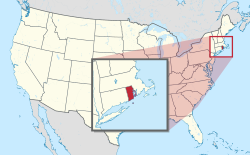U.S. Post Office | |
 (2021) | |
| Location | 5 High Street, [1] Westerly, Rhode Island |
|---|---|
| Coordinates | 41°22′40″N71°49′49″W / 41.3778°N 71.8302°W |
| Built | 1914 |
| Architect | James Knox Taylor |
| Architectural style | Classical Revival |
| Part of | (ID84002055) |
| NRHP reference No. | 71000004 [2] |
| Significant dates | |
| Added to NRHP | August 12, 1971 |
| Designated CP | July 19, 1984 |
High Street Station, formerly the main Westerly Post Office, is a historic United States post office at the intersection of Broad and High Streets in Westerly, Washington County, Rhode Island.



